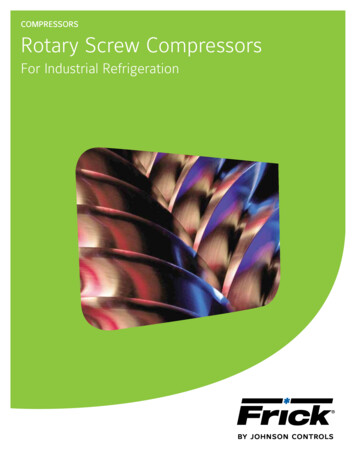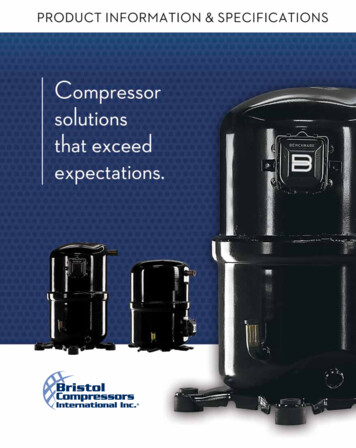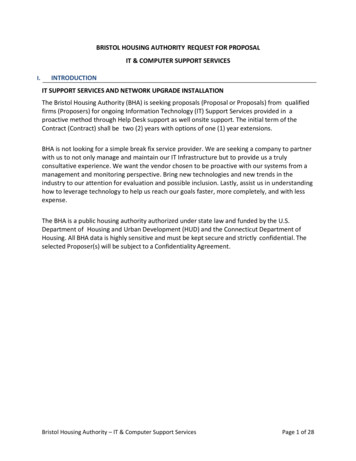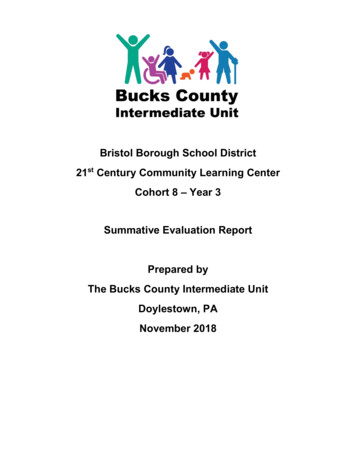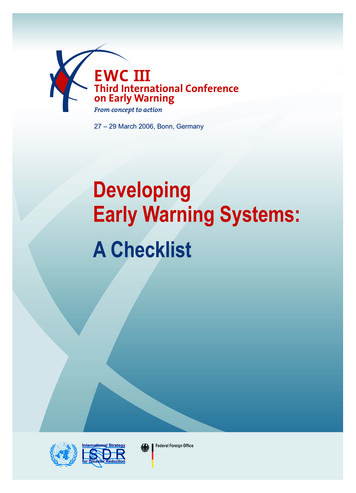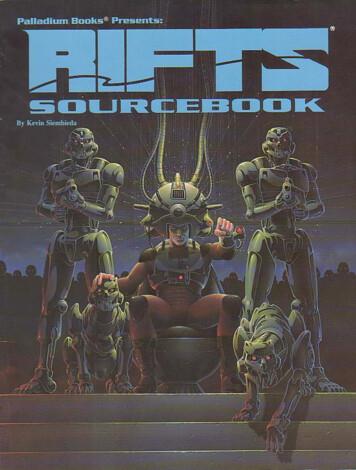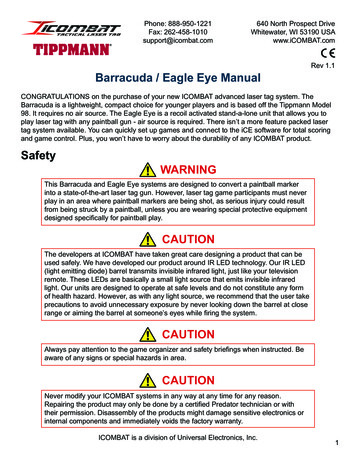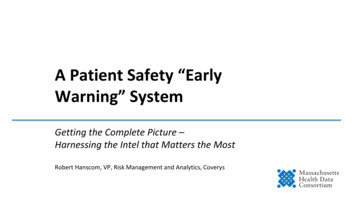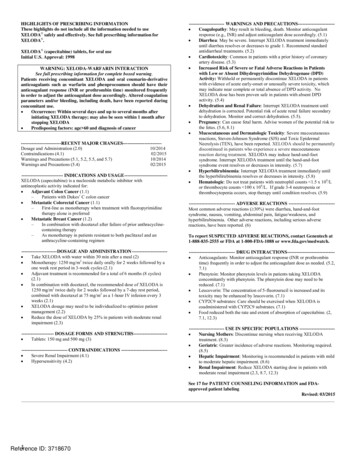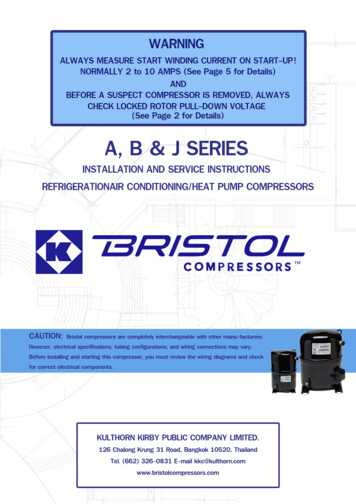
Transcription
WARNING: Read all procedures and warnings prior to performing maintenance! Foryour safety, it is essential that you use properly sized and operating test equipment.WARNING: Air conditioning and refrigeration systems are pressurized; hazards couldexist resulting in personal injury. It is therefore recommended that the following stepsfor troubleshooting, removal and installation of the hermetic compressor be performedby qualified experienced personnel only.WARNING: R410A systems operate at 50% - 60% higher pressure than R22. R22service equipment should not be used with R410A refrigerant. Refer to the attachedpressure temperature chart (see page 31 for comparison).BEFORE CONDEMNING A SINGLE-PHASE COMPRESSOR THAT FAILS TO START 1.Verify all following components are OK:A. Run capacitorB. Starting components (even if not originally installed, start assist should be tried before going to step 2)C. ContactorD. Winding resistance within manufacturer’s specification (assure compressor is cool to the touch)E. Compressor not grounded via ohmmeter/Megger, etc.F. Compressor power terminals are tight and secureG. Check for hot spots in system wiring (wire insulation melted, connectors, insulators melted, etc.)2.Verify locked rotor pull-down voltage (LRPDV). Always check LRPDV before removing the old or newreplacement compressor. If the LRPDV reduces the supply voltage to the compressor below the“guaranteed to start” voltage of the compressor (single-phase 230/208 LRPDV is 197v), the power supplymust be corrected before removing the compressor.Procedure to check for LRPDV:Warning! Make sure system is properly grounded before proceeding!A. Connect a voltmeter to the common terminal and run terminal of the compressor.B. Remove the start wire from the compressor and insulate the connector lead wire.C. Terminal cover and retainer MUST be installed before applying voltage. (See warning on page 5.)D. Apply voltage to the compressor and measure the voltage as the compressor attempts to start (duringlocked rotor). If internal overload trips, allow time for reset before continuing.E. If the voltage at the compressor terminals does not pull down below the LRPDV, reconnect the startwire and try to start again. If the compressor does not start, proceed to step 3 below.3.Direct wiring. This wiring eliminates all other components and system wiring.A. Hard-wire from a fused disconnect to the C and R terminals of the compressorB. Wire in a new run capacitor from the S terminal to the R terminal at the compressor using new wireleads (see page 9 permanent split capacitor-wiring diagram)C. Turn on disconnect, verify LRPDV and measure start winding current (see item 11, page 5)D. If compressor does not start, add a two-wire start assist kit in parallel with the run capacitor and repeatstep 3 (C). If the pressures are equalized and the LRPDV and start current are OK, and the compressor still does not start, it is definitely faulty.WARNING: Never use oxygen to pressurize a refrigeration or air conditioning system.Oxygen can explode on contact with oil and could cause personal injury. When usinghigh pressure gas such as nitrogen or CO2 for this purpose, be sure to use a regulatorthat can control the pressure down to 1 psig.Page 2
INSTALLATION PROCEDURES AFTER COMPRESSOR HAS BEEN VERIFIED AS FAULTY.The following instructions are general in nature but include major points of consideration that will ensure proper installation andprotect you from possible personal injury. Please use this as a checklist, taking each item in its order before proceeding to thenext. If more information is required, please call Bristol Compressors’ Service Department.VERY IMPORTANTDo not leave compressor or system open to atmosphere for longer than 15 minutes maximu. The Polyolester lubricants are atleast 100 times more hygroscopic (ability to absorb moisture) than mineral oils. It is almost impossible to remove the moistureabsorbed by the lubricant even with heat and vacuum.1.VERIFY PROPER APPLICATION.A.Verify that the compressor being replaced and the Bristol compressor have a like capacity for the refrigerantbeing used and that the voltage and frequency characteristics are the same.B.Verify if the new replacement compressor requires a discharge muffler. Do not remove the dischargemuffler from the system unless you replace it with the required muffler for the new compressor. See page13 for muffler information. Consult your wholesaler if you have any questions about proper compressor application.WARNING:2.To avoid electrical shock, power to the compressor should remain off during performanceof Steps 2 through 10.DETERMINE CAUSE OF INITIAL FAILURE. In order to prevent a second failure, the cause of the original failuremust be determined. Identify the cause and make the necessary repairs.A.BEFORE REMOVING THE FAULTY COMPRESSOR: Remove refrigerant charge using proper recoveryprocedures. Call 1-800-235-7882 for the name of the nearest Dupont authorized distributor, or1-800-631-8138 for Honeywell Chemical Representative or 1-800-725-5532 Mexichem for information on refrigerant reclaim programs.B.Remove the electrical leads from the compressor. Note and label the terminal to which each wire is connected.C.During the next operation, the access ports should be open so that pressure does not build up in the system. Use a high temperature torch to sweat the suction line and the discharge line loose from the compressor.D.Remove the faulty compressor.E.Assure excessive oil does not remain in the system. Measure oil in the failed compressor and, if oilis low, flush excess from system (or see alternative below).Good indicators of excess oil are: violent vibration and/or high variable sound as the extra oil movesthrough the system.Alternatives: If the excess oil cannot be flushed from the system, the last alternative is to reduce the oilcharge in the new compressor by the amount left in the system. This procedure should be used only if the following are true:- The oil remaining in the system is dry (i.e., system had not leaked down)- Oil type is same as in the replacement compressor- Compressor failure was not a motor burnout- The oil remaining in the system is less than 50% of the original oil charge- Suction filter drier must be installed Procedure if failed compressor has lost more than 50% of the original oil charge- Operate new compressor for 15 minutes in cooling mode (30 minutes if a suction line accumulator is installed)- Recover refrigerant and remove the compressor- Remove oil from the compressor and recharge with fresh oil per the manufacturer’s specificationsPage 3
CAUTION: The compressor may contain harmful acids—-be sure to handle with extreme care usingproper protection equipment. After confirming oil charge level, return oil to compressor and install suction and discharge rotalock caps. Copper tube fittings should be brazed closed. This is needed to prevent further contamination of the compressor and to prevent spillage from the compressor.3.MOUNT THE NEW COMPRESSOR. Do not remove dust cover or rubber shipping plugs until all other connections have been completed (i.e., filters installed and all tubing changes made—-see steps 4, 5 and 6). Again, thecompressor should not be open to the atmosphere for more than 15 minutes. Be sure to use the new mountinggrommets that were shipped with the compressor. If the mounting sleeves shipped with the compressor areused, the mounting bolts will bottom out when tight. Use care not to over-compress the mounting grommetswhen the mounting sleeves cannot be used.4.Install the proper discharge muffler if the system does not have one. Refer to Tables 3 and 4 on page 12 to confirm if the replacement compressor requires a discharge muffler and the size required. H22J and R92J compressors have an internal muffler, therefore, the tables do not apply to these two models.5.INSTALL FILTER DRIERS. Bristol Compressors recommends the use of new adequately sized liquid and suction line driers anytime a compressor is replaced. If the new compressor is to be used to replace a compressorwith a burned motor, the use of a high acid neutralizing filter drier is recommended. For heat pumps, a suctionfilter drier must be installed between the accumulator and the compressor suction inlet. In addition, a bidirectional heat pump liquid line drier or factory recommended driers must be installed. NOTE: ALWAYS REMOVE OLD FILTER DRIERS.6.BRAZE ON SUCTION AND DISCHARGE LINES. Flow an inert gas, such as nitrogen or CO2, through the system at approximately 1/4 to 1 psig. This will reduce the possibility of oxidation inside the tubing. Braze on thesuction and discharge lines and braze the process tube shut following the recommendation listed below. Note:The process tube has been eliminated on most compressors.COPPER TUBING:If additional copper tubing is required, use only clean, dehydrated refrigeration gradetubing with sealed ends.BRAZING ALLOYS:CAUTION: Do not use 95/5, 50/50 or 40/60 soft solder for brazing. Use Sil-Fosor Phos Copper, or similar brazing alloys with high tensile strength on copper weldsonly. Weld steel to copper only with silver brazing alloys.BRAZING PROCEDURE: To ensure properly brazed joints, Bristol Compressors recommends that the followingsteps be used:a. Exercise extreme care when cutting and forming tubes to keep dirt, filings, andother contaminants from entering the system.b. Do not use excessive amounts of brazing alloy as some of the excess may penetrate the joint and enter the system.c. If flux must be used, take necessary precautions to ensure that the flux does notenter the system.d. Use damp cloths or other heat absorbent material to ensure that the factorybrazed joints on the compressor do not become damaged. If damp cloths areused, take care not to allow moisture to enter the system.e. Do not overheat brazed joints as excess heat will cause formation of copper oxideon the inside wall of the tubing. Flow an inert gas through the system, as explained above.7.CHECK SYSTEM FOR LEAKS. After installation is complete, pressurize the system to 75 psig using nitrogenand a few ounces of system refrigerant. Check for leaks using a halide torch, soap bubbles or an electronichalogen leak detector. When all connections test satisfactorily, release pressure using proper recovery procedures, then proceed to next step.Page 4
8.CAUTION: The compressor may contain harmful acids—-be sure to handle with extreme care using properprotection equipment. After confirming oil charge level, return oil to compressor and install suction and discharge rotalock caps. Copper tube fittings should be brazed closed. This is needed to prevent further contamination of the compressor and to prevent spillage from the compressor.9.CHECK THE ELECTRICAL SYSTEM. While the system is evacuating, connect the electrical leads to the compressor terminals. Verify that the electrical system is wired according to the unit’s manufacturer and Bristol’s wiring diagram on page 9. Verify that the electrical components match those specified on the compressor electricaldata sheet on pages 14 through 30. Start components (start capacitor and relay) are required on all systems that incorporate a hard shut-off or non-bleed thermostatic expansion valve. It is a normal practice toreplace all starting components any time a compressor is changed. Check all connections and terminals to besure they are tight. Connect the crankcase heater (standard on all “A” Series). Power to the crankcase heatermust be energized continuously. Voltage to an insertion type heater can be anything between 187 to 600volts. If supplied, the insertion heaters are identified by their black or red leads coming from a well at thebottom of the compressor. Operational voltage for wrap-around type heaters must be verified.WARNING: Application of voltage to the compressor with the terminal cover and retainer removed can resultin serious personal injury or death.10.CHARGE THE SYSTEM. When a vacuum of at least 200 microns is reached, close gauge valve, remove vacuum pump, and break the vacuum by charging the system through the liquid line—-not the discharge line. Toassure the proper refrigerant composition is charged in the system with non azeotrope refrigerants, it is importthat liquid only be removed from the charging cylinder. Never dump liquid refrigerant into the compressor. Sincesome compressors may be damaged if liquid refrigerant enters the suction side of the compressor, it is importantto charge the refrigerant slowly into the suction line to allow it to vaporize before it enters the compressor. Athrottling valve can be used to ensure that the liquid is converted to vapor prior to entering the system.Charge the system according to the manufacturer’s specifications. Be sure to compensate the charge for the addition of the filter drier. Consult unit pressure/superheat chart on the unit door panel for the correct superheatsince pressures and superheat change with the ambient temperature.WEIGHING in the system charge to the factory specification will help point out system faults that maystill exist.11.START-UP. CLAMP-ON AMMETER MUST BE IN PLACE BEFORE POWER IS APPLIED TO MONITORSTART WINDING CURRENT ON START-UP!! See page 6.12.Most of today’s high efficiency compressors will actually start and run on the start winding if line voltage is applied to the start winding instead of the run winding (i.e., the start and run wire are reversed—-see schematic onpage 6). For this reason, the voltage must be checked on the common and run terminal of the compressor toconfirm the line voltage is being applied to the proper terminals. If the voltage on the common and run terminalsis higher than the line voltage supplied to the system—check system for proper wiring.ASSURE THESE NORMAL START WINDING CURRENTS ON START-UPCONFIGURATIONAPPROXIMATE CURRENTNORMAL START WITH RUN CAP ONLY2 - 10 AMPSNORMAL START WITH RUN AND START CAP20 AMPS AND DROP T
A. Verify that the compressor being replaced and the Bristol compressor have a like capacity for the refrigerant . Call 1-800-235-7882 for the name of the nearest Dupont authorized distributor, or 1-800-631-8138 for Honeywell Chemical Representative or 1-800-725-5532 Mexichem for information on re-frigerant reclaim programs. B. Remove the electrical leads from the compressor. Note and label .
